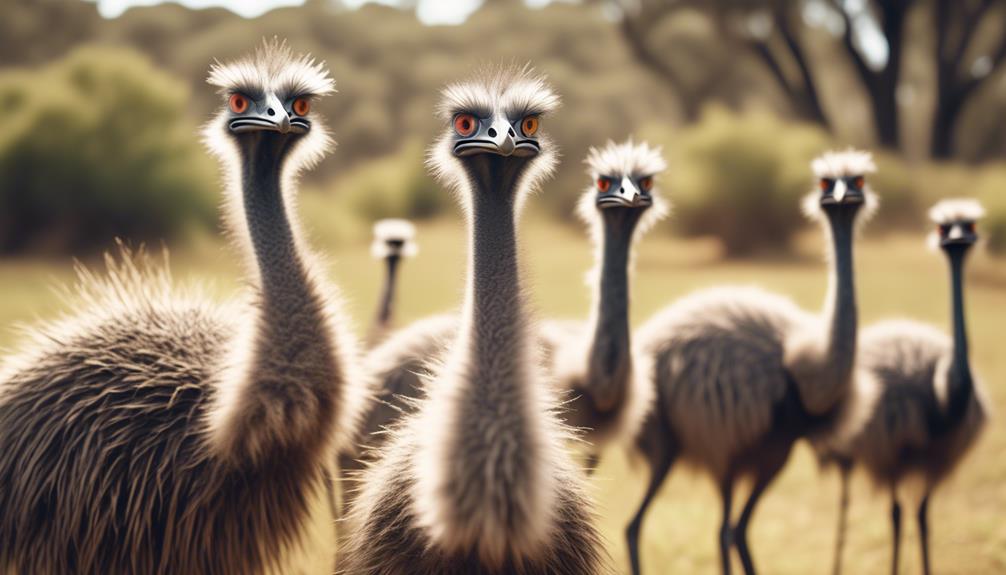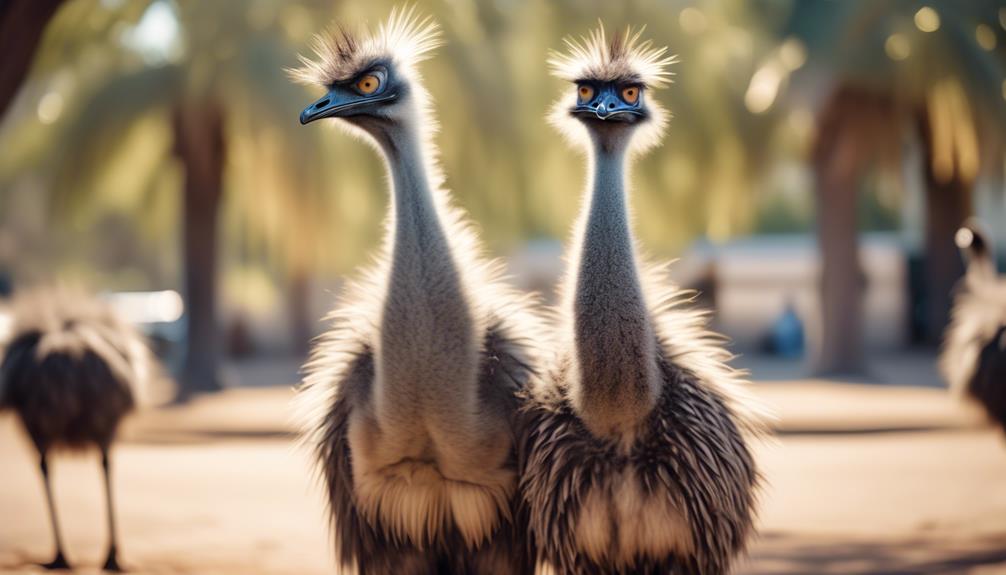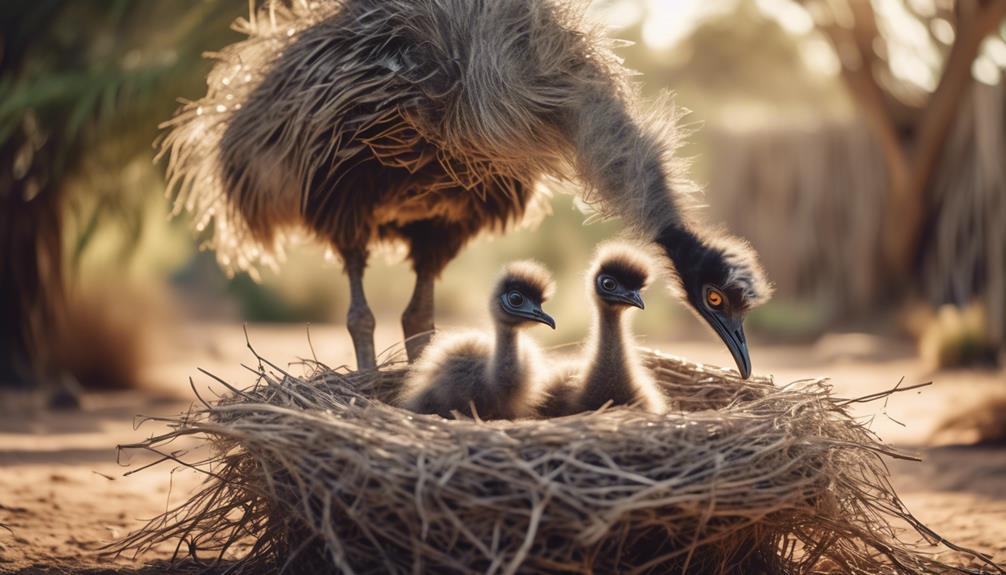
Did you know that emus are highly social birds that live in groups called mobs? With an average mob size of 10 to 20 individuals, these fascinating creatures have complex social structures and a wide range of behaviors to communicate with each other.
From vocalizations and body language to courtship rituals and parental care, emus have a rich repertoire of signals that allow them to interact and navigate their social world. But how exactly do they communicate?
In this discussion, we will explore the intricate world of emu behavior and communication, decoding their social signals and uncovering the mysteries of their fascinating interactions. Get ready to embark on a journey into the captivating world of emus and discover the hidden language of these remarkable birds.
Emu Social Structure

The social structure of emus is characterized by a hierarchical system based on dominance and territoriality. Emus in captivity exhibit similar social behaviors as their wild counterparts, despite the different environment. Within a captive group, emus establish a dominance hierarchy, with one individual assuming the role of the dominant bird. This dominance is established through displays of aggression, such as pecking, charging, and vocalizations.
Emus form social bonds within their groups, which are important for maintaining stability and cooperation. These bonds are primarily formed between individuals of the same sex, and can be observed through affiliative behaviors such as grooming, preening, and huddling together. Social bonds among emus in captivity are crucial for their overall well-being, as they provide a sense of security and companionship.
Territoriality is another key aspect of emu social structure. Emus in captivity exhibit territorial behaviors by defending their living space from other individuals. They do this through displays of aggression and vocalizations, signaling their ownership of the territory.
Understanding the social structure of emus, both in the wild and in captivity, is essential for creating suitable environments that promote their social well-being. Providing opportunities for social interaction and ensuring the establishment of a stable dominance hierarchy can contribute to the overall health and happiness of emus in captivity.
Vocalizations and Their Meanings
Having established the importance of emu social structure, it is now crucial to explore the intricate world of emu vocalizations and decipher their various meanings. Emu vocalizations play a vital role in their communication, allowing them to convey a range of messages to their flock members. By understanding the meanings behind these vocalizations, we can gain insight into the social dynamics and behaviors of these fascinating creatures.
Below is a table that outlines some of the most common emu vocalizations and their corresponding meanings:
| Vocalization | Meaning |
|---|---|
| Drumming | Indicates dominance or territory defense. Usually produced by males during breeding season. |
| Grunting | Communicates aggression or warning. Often heard during confrontations or when emus feel threatened. |
| Croaking | Signifies contentment or relaxation. Emus produce this low, throaty sound when they are at ease. |
| Trumpeting | Indicates excitement or alarm. This loud, trumpeting call is used when emus sense danger or during feeding frenzies. |
These vocalizations provide emus with a means to express their emotions, establish dominance, and communicate important information within their social group. By listening closely to their vocalizations, we can better understand the complex social interactions and behaviors that shape emu society.
As you observe emus in their natural habitat, take note of the vocalizations they produce and the context in which they are emitted. This will allow you to delve deeper into the fascinating world of emu communication, fostering a greater connection with these remarkable birds.
Body Language and Postures

Emu body language and postures provide valuable insights into their social interactions and behavioral patterns. As highly social creatures, emus rely heavily on nonverbal cues to communicate with one another. Observing their body language can help us understand their intentions, emotions, and social hierarchies.
One key aspect of emu body language is their neck and head movements. When an emu stretches its neck upward and extends its head forward, it's a sign of dominance or aggression. Conversely, when an emu tucks its head low and close to its body, it's expressing submission or fear. These postures are often accompanied by other behaviors such as fluffing up feathers or hissing, further emphasizing their communication intent.
Another important nonverbal cue in emu body language is their wing positioning. When an emu spreads its wings wide and holds them slightly away from its body, it's asserting dominance and signaling territorial ownership. On the other hand, when an emu wraps its wings tightly against its body, it's showing submissiveness or a desire to avoid conflict.
Understanding emu body language and postures can help us navigate their social dynamics and interpret their intentions. By paying attention to these nonverbal cues, we can gain a deeper understanding of these fascinating birds and their complex social interactions.
Courtship Rituals and Mating Behavior
Courtship rituals and mating behavior in emus are characterized by a series of intricate displays and interactions that serve to establish and strengthen pair bonds. These courtship displays play a crucial role in ensuring reproductive success among emus. Here are three key aspects of emu courtship and mating behavior:
- Elaborate Dance: Emus engage in a captivating courtship dance where they prance, strut, and twirl around each other. The male spreads his wings wide, fluffs his feathers, and makes deep drumming sounds by vibrating his throat. This display is aimed at attracting the attention of the female and showcasing the male's physical prowess.
- Vibrant Plumage: During courtship, male emus showcase their vibrant plumage to impress females. Their feathers become more erect, displaying vivid colors and intricate patterns. The male's plumage serves as a visual indicator of health and genetic quality, making it an important factor in female mate choice.
- Mutual Feeding: Another courtship behavior observed in emus is mutual feeding. Males and females take turns offering food to each other as a display of trust and bonding. This behavior fosters a sense of partnership and cooperation, strengthening the pair bond between the emus.
Understanding these courtship displays and mating behaviors provides insight into the complex social dynamics of emus and their strategies for reproductive success. Through these intricate rituals, emus establish and reinforce their pair bonds, ensuring successful reproduction and the continuation of their species.
Parental Care and Nesting Habits

Parental care and nesting habits in emus demonstrate a remarkable level of dedication and coordination between male and female partners.
Emu reproductive strategies vary significantly from other avian species, as both males and females actively participate in the incubation and rearing of their offspring. Once the female lays her eggs, the male takes on the responsibility of incubating them. During this period, the male emu constructs a nest by scraping out a shallow depression in the ground and lining it with grasses and leaves.
This nest construction not only provides a safe and comfortable environment for the eggs but also serves as a visual cue for the female to deposit her eggs. After the female lays her clutch, which typically consists of 8 to 12 eggs, she leaves the male to incubate them and find another mate. The male emu diligently incubates the eggs for approximately 56 days, rarely leaving the nest except to drink water or feed.
The male's dedication to his nest and eggs is evident in his constant vigilance and defensive behavior towards potential threats. Once the eggs hatch, both parents actively participate in caring for the young emus, teaching them important survival skills such as foraging and avoiding predators. The coordination and cooperation displayed by male and female emus in their parental care and nesting habits exemplify the strong bond between these partners, ensuring the successful reproduction and survival of their species.
Aggression and Conflict Resolution
Aggression and conflict resolution in emus reveal fascinating behavioral patterns and intricate social dynamics. These large flightless birds have developed various strategies to navigate conflicts within their groups. Here are three key observations regarding aggression triggers and conflict resolution strategies in emus:
- Territory defense: Emus are highly territorial creatures and will aggressively defend their space from intruders. Aggression is often triggered when another emu attempts to encroach upon their territory, resulting in intense displays of dominance and posturing. These behaviors, such as fluffing their feathers, hissing, and charging, serve as warnings to deter potential threats.
- Ritualized displays: Emus possess a repertoire of ritualized displays that play a crucial role in conflict resolution. When engaging in disputes, emus may engage in elaborate dances and vocalizations, showcasing their size and strength. These displays help establish dominance hierarchies and minimize physical confrontations, reducing the risk of injury.
- Vocal communication: Emus employ a range of vocalizations to communicate their intentions and resolve conflicts. From deep booming calls to high-pitched screeches, these vocal signals convey messages of aggression, submission, or appeasement. By vocalizing, emus can effectively communicate their intentions and diffuse tense situations, promoting social harmony within the group.
Understanding the triggers of aggression and the strategies emus use to resolve conflicts provides valuable insights into their complex social dynamics. These observations shed light on the intricate ways in which emus maintain social order and navigate interpersonal relationships within their communities.
Foraging and Feeding Patterns

Emus exhibit distinct foraging and feeding patterns. They have a selective herbivorous diet and efficient feeding strategies. These large, flightless birds have unique adaptations that allow them to efficiently locate and consume food in their natural habitat.
Emus primarily feed on a variety of plant material, including grasses, fruits, seeds, and flowers. Their feeding habits are opportunistic, as they can easily switch between different food sources depending on availability and nutritional needs.
Emus employ various foraging techniques to obtain their food. One common technique is pecking, where they use their long, slender beaks to probe the ground and extract plant material. They also use their beaks to pluck fruits and seeds from trees and shrubs. Additionally, emus are known to use their strong legs to kick and break open tough fruits, such as melons, in order to access the nutritious pulp inside.
Their efficient feeding strategies allow emus to maximize their intake of nutrients while minimizing energy expenditure. For example, they have a unique ability to store food in their crop, a specialized pouch in their esophagus. This allows them to consume large quantities of food in a short amount of time and digest it later at a more leisurely pace.
Group Dynamics and Hierarchies
In the social structure of emus, hierarchical dynamics play a vital role in establishing order and maintaining group cohesion. Emus, like many other social animals, exhibit dominance behavior and form hierarchies within their groups. These hierarchies are based on a variety of factors, such as age, size, and social status.
Here are three key aspects of emu group dynamics and hierarchies:
- Dominance Behavior: Emus use various displays and behaviors to establish dominance within their group. These may include puffing up their feathers, lowering their heads, and making low-frequency vocalizations. The dominant emu will often assert its dominance by excluding others from resources such as food and mates.
- Social Hierarchy: Emu groups have a clear social hierarchy, with dominant individuals occupying the highest rank. Lower-ranking emus are expected to show deference and respect towards higher-ranking individuals. This hierarchy helps to maintain order and reduce conflict within the group.
- Group Stability: Hierarchies in emu groups contribute to overall group stability. By establishing clear roles and relationships, emus can minimize aggression and maintain a harmonious social structure. This stability is crucial for the successful coordination of group activities, such as foraging and predator detection.
Understanding emu group dynamics and hierarchies provides valuable insights into their social behavior and communication. By studying these dynamics, researchers can gain a deeper understanding of how emus navigate their social world and maintain group cohesion.
Emus and Human Interaction

Human interaction with emus often involves careful observation and analysis of their behavior and communication patterns. Emus have gained popularity as therapy animals, providing comfort and emotional support to individuals in need. Their calm and gentle nature, combined with their unique physical appearance, make them ideal candidates for this role. Emus have also found their way into popular culture, appearing in various forms of media such as movies, books, and advertisements. Their distinctive appearance and intriguing behaviors have captured the imagination of many.
When interacting with emus, it's essential to approach them with respect and caution. These birds are naturally curious and may approach humans out of curiosity. However, it's crucial to remember that they're still wild animals and should be treated as such. Avoid sudden movements or loud noises that may startle them, as this can lead to unpredictable behavior.
Emus have a remarkable ability to communicate through a range of vocalizations, body language, and displays. By observing their behavior closely, you can gain insights into their emotions and intentions. Pay attention to their posture, feather fluffing, and vocalizations to understand their current state of mind.
Conservation Concerns and Future Research
As emus continue to captivate your imagination through their intriguing behaviors and unique physical appearance, it becomes increasingly important to address conservation concerns and prioritize future research efforts.
The emu population has been experiencing a decline in recent years, raising alarm bells among conservationists. To tackle this issue effectively, several conservation strategies should be implemented:
- Habitat preservation: Emus require vast areas of open grasslands and woodlands to thrive. Protecting their natural habitats from human encroachment and habitat degradation is crucial for their survival. This can be achieved through the establishment of protected areas and implementing sustainable land use practices.
- Captive breeding programs: Initiating captive breeding programs can help boost the emu population and provide a safety net against extinction. These programs involve breeding emus in controlled environments and reintroducing them into the wild when the conditions are suitable.
- Research on threats and mitigation measures: Conducting comprehensive research on the factors contributing to the decline in emu populations is essential. Understanding the specific challenges they face, such as habitat loss, predation, and climate change, will enable the development of effective mitigation strategies.
Frequently Asked Questions
How Do Emus Communicate With Each Other Over Long Distances?
Emus communicate with each other over long distances through a combination of vocalizations and visual displays. Their unique calls and body language allow them to convey important information and maintain social cohesion within their groups.
Are Emus Territorial and Defend Their Territories Against Other Emus?
Emus are territorial creatures and display aggressive behavior towards intruders. They defend their territories against other emus, using various signals and actions to communicate their dominance and protect their space.
What Are the Main Factors That Influence Emu Mating Choices?
Emu mating preferences are influenced by various environmental factors. These factors include availability of resources, quality of habitat, and competition for mates. Understanding these influences helps us decipher the intricate world of emu courtship.
Do Emus Exhibit Any Unique Behaviors During Courtship Rituals?
During courtship rituals, emus exhibit unique behaviors such as elaborate displays and vocalizations. These courtship displays serve as signals to attract a mate and establish dominance. Emu mating rituals are fascinating to observe and study.
How Do Emus Protect Their Nests From Predators?
Emus employ various nest defense strategies to protect their offspring from predators. They exhibit vigilant behavior, constantly scanning their surroundings and emitting alarm calls when sensing danger. This predator avoidance behavior ensures the safety of their nests.
Conclusion
In conclusion, through the study of emu behavior and communication, it's evident that these fascinating creatures possess a complex social structure and use vocalizations, body language, and postures to communicate with one another.
Their courtship rituals, parental care, and foraging patterns further highlight their intricate social dynamics.
Additionally, their interactions with humans raise important questions about conservation and future research.
By delving deeper into these topics, we can gain a better understanding of emus and ultimately contribute to their preservation.




